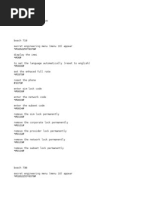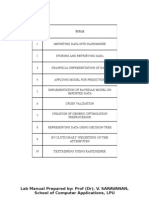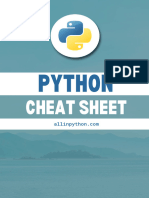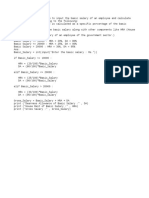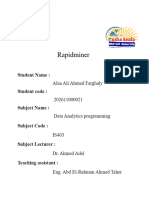Python Skill Test
Uploaded by
Siya KumariPython Skill Test
Uploaded by
Siya KumariPYTHON - SKILL TEST STRATAVAR © CONFIDENTIAL
Python - Skill Test
Subject: Python - Skill Test
Date: September 28, 2020
Version: 1.3
I INTRODUCTION
The objective of this task is to test the ability of the candidate to write code fragments in several areas of
programming that represent some StrataVAR typical use cases.
The development can be done using Python 2.7.x or 3.x, with an IDE at the programmer’s choice
(preferably PyCharm free community edition)
There is no time limit to complete the tasks, although time will be measured.
II. GENERAL GUIDELINES
(1) Develop the solution as Class/Method and use code to test various scenarios.
(2) Write and comment a few scenarios. As “Unit Test” utilizing the Class/Method you
developed.
(3) Each test should be document according to best-practice and at a logical level (I.E., do not
state the obvious, like when the code says.
i = i +1; //increment I by one – this comment is not adding any information, hence bad)
(4) In addition, use-best practices when writing the code in terms of method comments,
Python constructs use etc.
(5) Feel free to search Google. Make sure you know to explain what and how was used.
(6) The program must actually run under your choice of IDE and produce output as required.
1. EXCEL PARSING - TEST #1
(1) The objective is to read, and parse a given Excel file, using the “xlrd” module.
(2) The result should be nicely printed as a Dict (JSON)
(3) The input Excel has two parts: The header which is built like a form with labels and values,
followed by rows with several columns.
(4) Each label should be a key in the output Dict, with the corresponding value.
(5) The rows should be a list element in the DIct, where each item should have the column header
as the key.
(6) There is a list of fields that should be extracted from the header part, and a list of fields from
the columns. Fields not on the list should be ignored.
LAST UPDATED: 28-SEP-20 FILE: PYTHON SKILL TEST CONFIDENTIAL PAGE: 1
2020-07-29-DQM
ONLY.DOCX
PYTHON - SKILL TEST STRATAVAR © CONFIDENTIAL
(7) Date values (label has the string somewhere in it) should be converted to the forma “yyyy-
mm-dd”
(8) Header list to be extracted:
(a) The code should look for form field labels called “Quote Number”, “Date”, “Ship To”, “Ship
From”, “Name”.
(b) The value is usually to the right of the label.
(c) There is one exception, and that is “Name”, that both label and value are stored in the same
Excel cell with a colon as a separator (like “Name: StrataVAR”).
(9) Item columns to be extracted: LineNumber, PartNumber, Description, Price. Other columns
should be ignored.
(10) Incase an expected field is not found, print a detailed error message to the console, continue
the process nevertheless.
The items have a heading row that always start with ‘LineNumber” field. The list of items ends when
either the Excel file is exhausted or a separator that has at least 10 dashes (‘----------') is found in first
column
Sample output:
{
'Quote': '1234',
'Date': '2019-03-31',
'Items':
[
{
'LineNumber': 1,
'PartNumer': 'ABC',
'Description': 'very good',
'Price': 123.45
},
{
'LineNumber': 2,
'PartNumer': 'XYZ',
'Description': 'Not very good',
'Price': 678.9
}
]
}
LAST UPDATED: 28-SEP-20 FILE: PYTHON SKILL TEST CONFIDENTIAL PAGE: 2
2020-07-29-DQM
ONLY.DOCX
PYTHON - SKILL TEST STRATAVAR © CONFIDENTIAL
2. DISTI QUOTE MERGE SIMULATION– TEST #2
Please write a Python class and a Test Class that resolves the following problem.
The sample data should be used in the Test Class. The method should be generic and
receive the data as input and return the result. The test class should use python’s print
function to print the Unified List table. You can Copy/Paste the result from the log.
Create hard coded test data, and show as output the “Unified List”
No need for fancy printout. A simple print will suffice.
The Input:
1. 2 lists of key: value pairs called “BoM” and “Disti”
2. Each list element has “Part Number” as a key and “Quantity” as a number.
3. Part Number may appear multiple times in the BoM with an arbitrary Quantity
(including zero)
4. Part Number will appear only once in Disti, in other words, Quantities will be
aggregated.
5. Part Numbers may exist only in BoM or only in Disti (there is no quantity zero)
The purpose is to “intelligently” compare the BoM and Disti, after fixing the Disti
Quantity if needed, and showing items missing on each side.
The Expected Result.
1. Create a 3rd list, with 5 fields: bom_pn, bom_qty, Dsti_pn, Dsti_qty, Error Flag.
2. All items from the BoM will appear as is and based on the same order of the input
BoM.
3. Against each bom_pn there should be a Dsti_pn (if one exists). If Disti PartNumber
is missing a Part Number in Disti, the Disti side should be left blank and Error Flag
should be checked
4. It is possible that Disti will be missing PN or BOM will be missing some Part
Numbers
5. If Disti Quantity is bigger than BoM Quantity (for any given Part Number), Disti
line should be split to match the Quantity of the BoM, and the remainder should
be aligned with another BoM line, if exists.
6. If there is another record with same part number, the above should be repeated.
7. The joint list should be as similar as possible in term of quantities.
8. You may end up with some lines that do not have a Disti values, and vice-a-versa.
9. No matter what, the overall quantities per Part Number on BoM side in the
Unified List output table should be the same as the original BoM. Same for Disti.
LAST UPDATED: 28-SEP-20 FILE: PYTHON SKILL TEST CONFIDENTIAL PAGE: 3
2020-07-29-DQM
ONLY.DOCX
PYTHON - SKILL TEST STRATAVAR © CONFIDENTIAL
10. The Disti Side, as a whole, should include ALL items from original Disti, even if
lines were split.
LAST UPDATED: 28-SEP-20 FILE: PYTHON SKILL TEST CONFIDENTIAL PAGE: 4
2020-07-29-DQM
ONLY.DOCX
PYTHON - SKILL TEST STRATAVAR © CONFIDENTIAL
Test Data
Below is the test data you must use (build hard coded list of and the expected result of
the algorithm. The code must actually run and produce results using print function.
Key:Value pairs)
This will be tested against some hidden test cases at our end.
Develop the class/methods and a unit test with the sample data given below.
The Test Data below must be used in the test class.
BoM
Part Number Quantity
ABC 2
XYZ 1
IJK 1
ABC 1
IJK 1
XYZ 2
DEF 2
Disti
Part Number Quantity
XYZ 2
GEF 2
ABC 4
IJK 2
Unified List
BoM PN BoM Qty Disti PN Disti Qty Error
Flag
ABC 2 ABC 2
XYZ 1 XYZ 1
IJK 1 IJK 1
ABC 1 ABC 1
IJK 1 IJK 1
XYZ 2 XYZ 1 X
DEF 2 X
GEF 2 X
ABC 1 X
LAST UPDATED: 28-SEP-20 FILE: PYTHON SKILL TEST CONFIDENTIAL PAGE: 5
2020-07-29-DQM
ONLY.DOCX
PYTHON - SKILL TEST STRATAVAR © CONFIDENTIAL
GOOD LUCK!
StrataVAR Inc.
No liability is assumed as a result of their use or application. Copyright © 2020 StrataVAR LTD. All
Rights Reserved.
LAST UPDATED: 28-SEP-20 FILE: PYTHON SKILL TEST CONFIDENTIAL PAGE: 6
2020-07-29-DQM
ONLY.DOCX
You might also like
- The C# Player's Guide - 5th Edition - 5.0.083% (18)The C# Player's Guide - 5th Edition - 5.0.0497 pages
- Introduction To Computer Theory by Cohen Solutions Manual80% (5)Introduction To Computer Theory by Cohen Solutions Manual198 pages
- Ap Computer Science Principles Practice Exam and Notes 202186% (7)Ap Computer Science Principles Practice Exam and Notes 2021108 pages
- Instant Download Database Management Systems Ramakrishnan 3rd Edition Raghu Ramakrishnan PDF All Chapters100% (1)Instant Download Database Management Systems Ramakrishnan 3rd Edition Raghu Ramakrishnan PDF All Chapters65 pages
- Hacking The Art of Exploitation 2nd Edition Jon Erickson100% (20)Hacking The Art of Exploitation 2nd Edition Jon Erickson492 pages
- PrepTest 83 - Print and Take Test - 7sage Lsat100% (3)PrepTest 83 - Print and Take Test - 7sage Lsat46 pages
- HCIA-Cloud Computing V5.0 Learning GuideNo ratings yetHCIA-Cloud Computing V5.0 Learning Guide274 pages
- How To Start A Research Work in Computer Science PDFNo ratings yetHow To Start A Research Work in Computer Science PDF4 pages
- Sociology 13th Edition Richard T. Schaefer All Chapter Instant Download100% (14)Sociology 13th Edition Richard T. Schaefer All Chapter Instant Download70 pages
- p74-MedBlock - Efficient and Secure Medical Data Sharing Via BlockchNo ratings yetp74-MedBlock - Efficient and Secure Medical Data Sharing Via Blockch11 pages
- How To Import JSON To Excel Using VBA - Excelerator SolutionsNo ratings yetHow To Import JSON To Excel Using VBA - Excelerator Solutions15 pages
- PDF Test Bank For Ethical Obligations and Decision Making in Accounting: Text and Cases, 5th Edition, Steven M Mintz, Roselyn E. Morris Download100% (4)PDF Test Bank For Ethical Obligations and Decision Making in Accounting: Text and Cases, 5th Edition, Steven M Mintz, Roselyn E. Morris Download55 pages
- Full A Nurse S Step by Step Guide To Writing A Dissertation or Scholarly Project Second Edition Karen Roush PDF All Chapters100% (4)Full A Nurse S Step by Step Guide To Writing A Dissertation or Scholarly Project Second Edition Karen Roush PDF All Chapters62 pages
- Using Template Bookmarks For Automating Microsoft Word ReportsNo ratings yetUsing Template Bookmarks For Automating Microsoft Word Reports15 pages
- A Beginner S Guide To Learning Power BI The Right WayNo ratings yetA Beginner S Guide To Learning Power BI The Right Way7 pages
- Website: VCE To PDF Converter: Facebook: Twitter:: Number: 1z0-148 Passing Score: 800 Time Limit: 120 MinNo ratings yetWebsite: VCE To PDF Converter: Facebook: Twitter:: Number: 1z0-148 Passing Score: 800 Time Limit: 120 Min54 pages
- Full download Principles and Practice of Case-based Clinical Reasoning Education : A Method for Preclinical Students 1st Edition Olle Ten Cate pdf docx100% (1)Full download Principles and Practice of Case-based Clinical Reasoning Education : A Method for Preclinical Students 1st Edition Olle Ten Cate pdf docx55 pages
- Business Requirements Document /: Project Name Module NameNo ratings yetBusiness Requirements Document /: Project Name Module Name11 pages
- Community Session - PromptEngineering-Fine-TuningNo ratings yetCommunity Session - PromptEngineering-Fine-Tuning34 pages
- A Review of Safe Reinforcement Learning - Methods, Theories and ApplicationsNo ratings yetA Review of Safe Reinforcement Learning - Methods, Theories and Applications97 pages
- SAS Job Execution Web Application 2.1 - User S GuideNo ratings yetSAS Job Execution Web Application 2.1 - User S Guide94 pages
- Data Scientist Certification Study GuideNo ratings yetData Scientist Certification Study Guide7 pages
- Family Health Care Nursing Theory Practice and Research 5th Edition Joanna Rowe Kaakinen Rn Phd Pnp 2024 scribd download100% (2)Family Health Care Nursing Theory Practice and Research 5th Edition Joanna Rowe Kaakinen Rn Phd Pnp 2024 scribd download61 pages
- XXXXX Mob No: +91-: Cytogenomics India Pvt. LTDNo ratings yetXXXXX Mob No: +91-: Cytogenomics India Pvt. LTD4 pages
- Introduction To Python Programming: Dr. R. Rajeswara Rao Professor & Head Dept. of CSE Jntuk-Ucev VizianagaramNo ratings yetIntroduction To Python Programming: Dr. R. Rajeswara Rao Professor & Head Dept. of CSE Jntuk-Ucev Vizianagaram27 pages
- (Ebook) Spark in Action - Second Edition: Covers Apache Spark 3 with Examples in Java, Python, and Scala by Jean-Georges Perrin ISBN 9781617295522, 1617295523 download pdf100% (9)(Ebook) Spark in Action - Second Edition: Covers Apache Spark 3 with Examples in Java, Python, and Scala by Jean-Georges Perrin ISBN 9781617295522, 1617295523 download pdf55 pages
- Kmeans Matlab Code Feed Own Data Source - QuestionInBoxNo ratings yetKmeans Matlab Code Feed Own Data Source - QuestionInBox5 pages
- Codingcompiler Com Python Coding Interview Questions AnswersNo ratings yetCodingcompiler Com Python Coding Interview Questions Answers20 pages
- Full download Modern Statistics with R From Wrangling and Exploring Data to Inference and Predictive Modelling Second Edition Måns Thulin pdf docx100% (2)Full download Modern Statistics with R From Wrangling and Exploring Data to Inference and Predictive Modelling Second Edition Måns Thulin pdf docx71 pages
- Python Full Stack Syllabus Course BrochureNo ratings yetPython Full Stack Syllabus Course Brochure27 pages
- Coding With JavaScript For Dummies Everything To Know About JavaScript (2020) - 40153100% (1)Coding With JavaScript For Dummies Everything To Know About JavaScript (2020) - 40153247 pages
- NWO, Illuminati, Freemason, Occult, Bible Prophecy, Conspiracy, Secret Society, Etc. LinksNo ratings yetNWO, Illuminati, Freemason, Occult, Bible Prophecy, Conspiracy, Secret Society, Etc. Links47 pages
- Structured and Unstructured Maintenance With Example0% (1)Structured and Unstructured Maintenance With Example9 pages
- Python Programming For Beginners - A Crash Course To Learn Python and Other Recommended Coding83% (6)Python Programming For Beginners - A Crash Course To Learn Python and Other Recommended Coding86 pages
- LINUX COMMAND LINE An Introduction To Linux Command Line EnvironmentNo ratings yetLINUX COMMAND LINE An Introduction To Linux Command Line Environment174 pages
- Learn To Code HTML and CSS Develop Style Websites PDF100% (2)Learn To Code HTML and CSS Develop Style Websites PDF595 pages
- How To Use PATS Module Initialization FunctionNo ratings yetHow To Use PATS Module Initialization Function5 pages
- (Ebook) Cloud Native Architecture and Design: A Handbook for Modern Day Architecture and Design with Enterprise-Grade Examples by Shivakumar R Goniwada ISBN 9781484272251, 1484272250 - Read the ebook online or download it for a complete experience100% (2)(Ebook) Cloud Native Architecture and Design: A Handbook for Modern Day Architecture and Design with Enterprise-Grade Examples by Shivakumar R Goniwada ISBN 9781484272251, 1484272250 - Read the ebook online or download it for a complete experience80 pages
- Shreeyash College of Engineering and Technology (Polytechnic), Chh. Sambhajinagar Micro-Project ReportNo ratings yetShreeyash College of Engineering and Technology (Polytechnic), Chh. Sambhajinagar Micro-Project Report17 pages
- Manager Report (Manager - Report With STA5.FMX)No ratings yetManager Report (Manager - Report With STA5.FMX)6 pages
- Addition of Name of Child in Birth CertificateNo ratings yetAddition of Name of Child in Birth Certificate7 pages
- Cisco 350X Series Stackable Managed SwitchesNo ratings yetCisco 350X Series Stackable Managed Switches32 pages
- Sample Configurations: Example 1: Multiple Mode Firewall With Outside AccessNo ratings yetSample Configurations: Example 1: Multiple Mode Firewall With Outside Access44 pages
- Excel Shortcut and Function Keys Microsoft Office Excel 2003No ratings yetExcel Shortcut and Function Keys Microsoft Office Excel 20035 pages
- Go - Na03 - E1 - 1 GSM Gprs Edge Basic Principles-49No ratings yetGo - Na03 - E1 - 1 GSM Gprs Edge Basic Principles-4949 pages
- Inkscape Tutorial For Beginners: How To Make A Yoga Classes FlyerNo ratings yetInkscape Tutorial For Beginners: How To Make A Yoga Classes Flyer21 pages
- CSC413 - Computer Networks and Communication - BOSUNo ratings yetCSC413 - Computer Networks and Communication - BOSU50 pages










